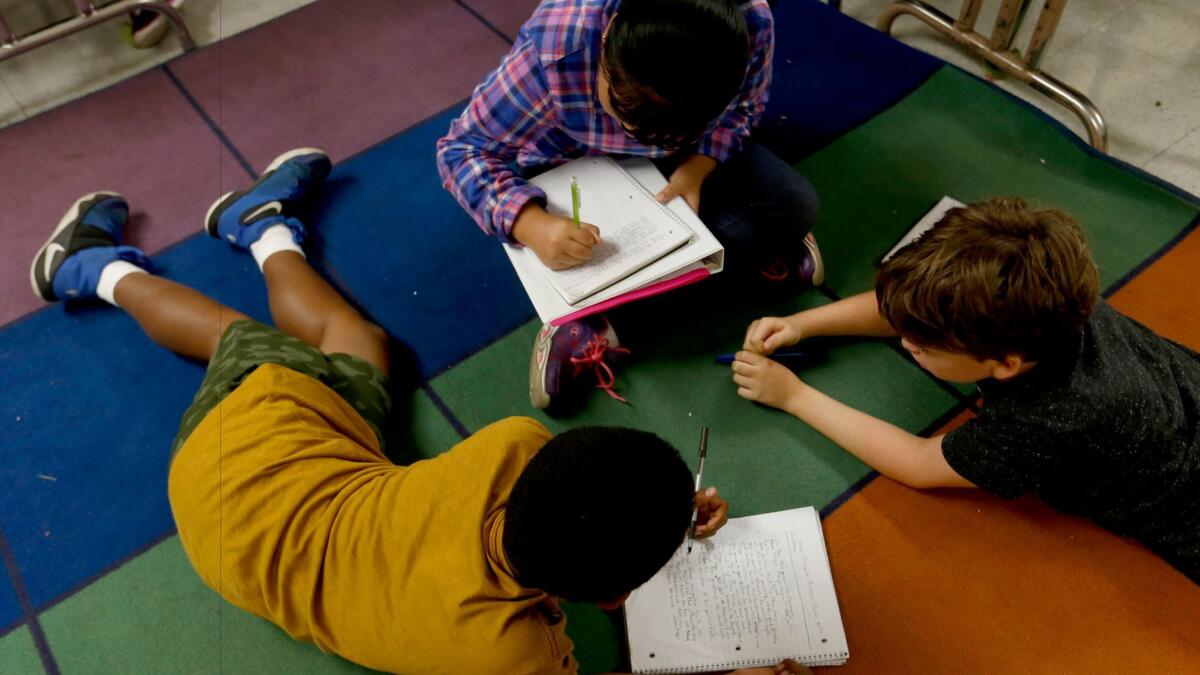California’s new education ratings tool paints a far rosier picture than in the past

When they unveiled the California School Dashboard on Wednesday, state officials described it as the most comprehensive way yet to assess the state of California public schools.
Supt. of Public Instruction Tom Torlakson heralded the website as “a resource unlike anything we’ve ever had before” and “a high-tech report card for our schools.”
But the new system, which is color coded, grades on a curve and paints a far rosier picture in academics than past measurements, a Times analysis found.
Nearly 80% of schools serving grades three through eight are ranked as medium- to high-performing in the new ratings, earning them positive colors on report cards sent to parents.
Last year in state testing at those same schools, the majority of students failed to reach English and math standards. More than 50 of those schools whose average math scores fell below proficiency receive the dashboard’s highest rating for math. (The dashboard does not include high school scores.)
The shift in outlook is intentional. The dashboard reflects a new, more holistic approach to evaluating schools, one that does not see test scores as the be all and end all. It also emphasizes progress and so heaps praise on schools that do poorly but see significant score increases from one year to the next.
In response to The Times’ analysis, officials said it’s important to reward schools that show growth.
The dashboard’s predecessor, the Academic Performance Index, was simple to read. It gave each school a number based solely on test scores. The dashboard is harder to understand, in part because it strives to move beyond those scores and capture the complex web of values that make a school good or bad.
Instead of numbers, California’s schools now get colors. Red represents the lowest possible performance, orange is low, yellow is medium, green is high and blue is very high. Just like on a car dashboard, red and orange demand attention.
A school does not get a color rating for overall performance. It might get a rainbow of ratings in areas that include reading and math performance, as well as rates of graduation, English-language acquisition for nonnative speakers and suspension. And in each area, it gets credit for progress.
The dashboard ultimately will provide the backbone for how districts and the state rate schools — which ones they praise and where they intervene. Parents will rely on it when they pick schools for their children.
That’s why it matters that the color-coded system is, at least to according to some, too generous.
Carrie Hahnel, deputy director of research and policy at the Education Trust–West, an Oakland-based advocacy group focused on educational equity, called the spread of academic ratings “terribly misleading.” “It doesn’t do anybody any favors,” she said, “to communicate that things are just fine if they’re not.”
The state, though, defended its methodology, including grading on a curve. “You don’t want to have an accountability system come out and say there’s not going to be any blue or green schools,” said Jenny Singh, an education research and evaluation administrator at the California Department of Education.
Brooklyn Avenue Elementary in East Los Angeles — whose principal did not immediately respond to requests for comment — is a case study in how the friendly curve might change opinions without schools changing much at all.
When test scores for the 2015-16 academic school year were released, just above half of Brooklyn’s students failed to meet state goals for math. Now, in its math marks on the dashboard, Brooklyn earns blue — the highest rating. That’s because Brooklyn’s math scores grew by 16 points.
On the other hand, more than 90% of students at West Hillsborough Elementary in San Mateo County scored above proficient in math. But that school only got a green for that subject because its scores declined slightly.
“It seems almost intentionally complex,” Tim Daly, the co-founder of EdNavigator, a New Orleans-based group that helps parents engage with schools, said of the overall approach. “The dashboard seems to go to great lengths to not make any clear statements about school performance.”
In L.A. Unified, test scores released last fall showed relatively low scores with some growth. But, because the growth is taken into account, the majority of its schools now get yellow — or medium — academic ratings.
LAUSD officials called the dashboard useful. “The positive is that it’s based on multiple measures,” said Cynthia Lim, who heads data and accountability for the district. “There’s going to be a learning curve.... But everyone is thinking this is a fairer way of looking at schools.”
Lim explained the new system Wednesday to a group of principals in the auditorium of East Valley High School in North Hollywood.
“The good news is, there’s nothing we haven’t already been tracking,” she said, as several principals raised their phones to take pictures of her slideshow. When a slide showed how colors on the dashboard are displayed in circles that look like Trivial Pursuit pieces, some principals giggled.
They had trouble immediately accessing the site because there were some technical glitches. But they applauded the value assigned to student growth.
When Lim said that L.A. Unified will get data for the dashboard from MiSis, the district’s notoriously faulty information system, one principal said ”Oh boy” under her breath. Lim explained that the district has added a new layer of software to track errors in data entry.
Principals were not told explicitly what colors they should aim for or the consequences of low performance. The dashboard is just being tested out this year, Lim said. Accountability will come later.
Statewide, the majority of schools ranked blue or green for graduation and suspension rates. The aggregate numbers, however, do not include alternative schools, which often bring down such rates.
It remains unclear how the dashboard will be used with regard to those schools that need help.
To read the article in Spanish, click here
Times staff writers Ben Welsh and Howard Blume contributed to this report.
ALSO
The California Schools Dashboard is live. How will you use it?
Trump wants to create a national private school choice program. Here’s how it could work
L.A. Unified will sign on to sanctuary city lawsuit against Trump administration
More to Read
Sign up for Essential California
The most important California stories and recommendations in your inbox every morning.
You may occasionally receive promotional content from the Los Angeles Times.












